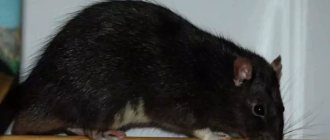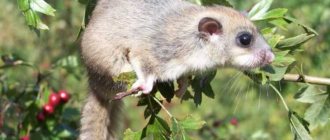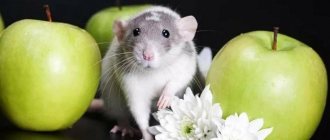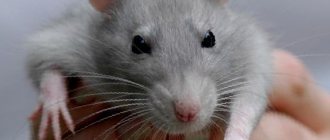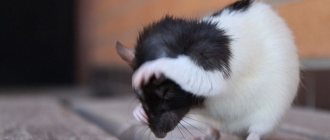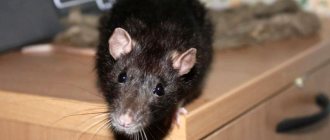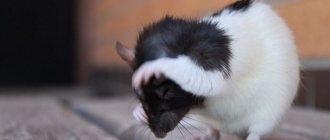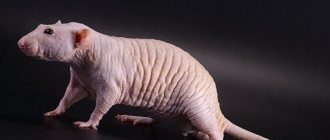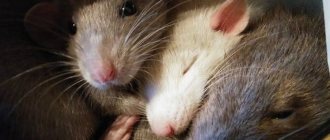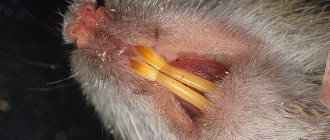Nobody knows when people first became acquainted with rats; this animal always lives next to us.
The rat belongs to the mammals, to the order - rodents, suborder - mouse-like. The most common animal on the planet is the rat.
Appearance of the rat, description and characteristics
The body of the rat is oval-shaped and stocky. The body of the animal is from 8 cm to 30 cm, weighing up to 500 g, there are small ones weighing 37 grams.
The eyes and ears are small, the muzzle is sharp and elongated. Is the tail longer than the size of the rat's body, hairless or covered with fine hair? invisible to the human eye (a type of black rat has a tail with a thick coat of fur). There is a species of short-tailed rodents in the world.A rat's teeth are arranged tightly together in rows and are designed for chewing food. These animals are omnivores; they differ from other predators in the absence of fangs and diastema - this is an area on the gums where there are no teeth.
There are no dental roots, so growth occurs continuously throughout the rat's life. For convenience, they need to constantly grind down their teeth, otherwise she will not be able to close her mouth.
The teeth are strong with hard yellow enamel, which makes it possible to easily chew through concrete, cement and hard various metals.
The rodent's body is covered with a thick, dense coat of guard hairs. The color range is varied, gray with different shades of dark or light, red, orange and even yellow.
These amazing animals have movable toes on their paws, so they easily climb trees and prepare nests in hollows for habitat.
Rats are very active and agile animals, running 17 km a day and jumping up to 1 meter in height. They swim well, are not afraid of water and can catch fish.
Rats often turn their heads in different directions because they have a small viewing angle and see the world around them in gray tones.
Hearing functions perfectly, rats distinguish sounds with a frequency of up to 40 kHz (humans up to 20 kHz).
Life expectancy is from 1 year to 3 years. In laboratory conditions, rats can live 2 times longer.
Rat houses
In nature, gray rats build their home in a hole about 80 cm deep. The length of the corridor reaches several meters. In the very depths, the animals make a nest, insulating it with blades of grass, feathers, and hairs. The common gray rat, living close to the water, in order to avoid flooding during floods, settles in hollows or builds a nest in a tree. Rodents that live near people build nests from all available materials. They can make kubla in things, for example, in a closet that is rarely looked at, in carpets rolled up for storage, in hay that has been folded for storage. In nests, females care for babies, and several broods can be in one place at the same time, and mothers care for the children together.
Difference between rats and mice
Rats and mice are representatives of the same suborder, but they differ significantly in appearance and behavior.
The body of a mouse is small, up to 20 cm, weighing up to 50 grams, rats are twice as large, they are dense and muscular, weighing up to 900 grams.
Pronounced distinctive shapes of the head and eyes, in mice it is triangular and slightly flattened with large eyes, in rats the muzzle is elongated with small eyes.
A strong body and powerful toes allow rats to jump high up to 1 meter; mice cannot do such tricks.
- Detailed description with photos of all animals included in the Red Book of Russia
Zebra - habitats, appearance, diet and behavior, life cycle + 94 photos
Leopard - habitats, life cycle, rutting season and lifespan + 118 photos
Mice are cowardly animals and are afraid to appear in front of people, but this does not bother rats; they can defend themselves. There are many cases where they attacked a person.
Rats are omnivores, eating meat and plant foods. On the contrary, mice have a greater preference for cereals and seeds.
Features of behavior
These creatures prefer to live in groups and endure loneliness only when necessary. The family always has a main male, a pair of his deputies, a harem of females and simple members (young individuals, weak males) who do not take part in reproduction. There is no mutual assistance between them, just like there is no communal labor like ants or bees. Among rats, everyone cares only about themselves, but if a stranger suddenly joins the family, they kill him together, although, in principle, they are not aggressive and do not attack unnecessarily.
The gray rat also resorts to the help of its fellow tribesmen to obtain food. The photo above shows how they steal birdseed as a well-coordinated team. Another feature of a collective organization is the fact that a poison that kills one member of the family will be avoided by others. These animals are smart and quick-witted. An experiment was conducted in which cheese was placed in a maze, and the rat not only quickly found the treat, but also remembered the path, and if the food was moved to another place, the animal no longer used the old path, although the smell of cheese remained there.
Why are rats dangerous?
Rats are a disaster for all humanity. They gnaw through walls in the basements of houses, sewer pipes, damage electrical mains, and damage crops.
Rats are carriers of more than 20 infectious diseases, such as leptospirosis, plague, salmonellosis, pseudotuberculosis and others. Many are dangerously fatal to human life.
It is difficult to exterminate rats using chemicals because the animal’s body quickly adapts to the poison and develops protective immunity to toxins.
Sex determination in rat pups
Even an experienced breeder will not be able to see the differences between the genitals of newborn males and females with the naked eye. Therefore, the following indirect signs come to the rescue:
- In girls, clearly defined nipples are located on the sides of the abdomen; in boys, the mammary glands are either very weakly expressed or completely absent;
- in males, two dark spots are visible at the base of the tail - the future location of the testes;
- in newborn girls, the distance between the tail and the urethra is much shorter than in boys - 2-2.5 mm; in males this figure reaches 5-6 mm.
Often small animals break free and try to escape during the inspection. Therefore, in order to examine the distinctive features in detail, you will need to record the rodent.
This is quite easy to do. You need to take the little rat by the tail with one hand, and with the other hand, gently hold it by the skin behind the ears - this way its movements will be limited.
Also, when identifying the sex of a particular individual, it is recommended to compare all the babies in the litter. This way the gender differences between the pups will be more obvious.
It is better not to touch newly born rat pups with your hands at all, so that they do not acquire a foreign smell. In such a case, the female may refuse them and stop breastfeeding. It is better to wait until the babies are 2-3 weeks old.
Rats are a pet
Rats are ideal pets. They quickly become tamed to humans and recognize their owner by the face.
Neat and clean animals do not require special care. They will give their owner many funny moments; they are very interesting to watch.
But the owner of a pet rat should not forget that this is a social animal and it is difficult for him to live alone. The rat definitely needs a mate, otherwise a mental disorder may develop.
Nutrition
What does this rodent eat? The gray rat is an omnivore. In nature, its diet consists of insects, lizards, chicks, bird eggs, cereals, root vegetables, and fruits. Rodents living near water eat small fish, mollusks, and crustaceans. Rats that settle in populated areas eat everything that they can steal from a person - any prepared food, any products, garbage, leftovers. It’s hard to understand why, but they chew paper, clothes, shoes, polystyrene foam, wooden products, electrical wiring - in short, everything that their powerful teeth can bite through. In villages, these little monsters eat chickens, newborn rabbits, and bite off the paws of adult rabbits that are locked in small cages. Male rats even eat their own children. Females are a little kinder; they eat only those babies that seem weak to them. They can survive only 4-5 days without food.
Type of rat, name and photo
There are about 70 species of rats in the world, most of which are little studied; below are common types of rodents with a brief description and photo of the rat.
The gray rat (pasyuk) is one of the larger species, up to 25 cm long, the tail is not taken into account. Weight from 140 grams to 390 grams, with a wide, elongated muzzle. The gray coat of young animals becomes orange with age. It lives near water, in dense vegetation and digs holes up to 5 meters.
The black rat is smaller in size than the gray rat, with a much smaller muzzle and rounded ears. Body length up to 22 cm, weight about 300 grams. A significant difference between this species of rodent is the tail, which is densely covered with hair and 4-5 times longer than the size of the body.
Lives in Asia, Africa and Europe. It can live for a long time without water, so it lives in dry places. The wool is black with a green tint.
The small rat differs from its fellows in size. Body length up to 15 cm maximum with body weight up to 80 grams. It has a brown coat color, a sharp muzzle and inconspicuous small ears. The tail is as long as the body without any signs of fur. Lives in Southeast Asia.
The long-haired rat is characterized by long hair and high activity. Males grow up to 18 cm, and females up to 16 cm in length. The tail is 4-5 cm smaller in size from the body. Habitat in arid deserts.
The Turkestan rat lives in China, Nepal, Afghanistan, and Uzbekistan. The fur is red, the belly is pale yellow, the body length is up to 23 cm. This variety is similar to the gray one, but has a denser body and a wide head in size.
Black-tailed rat or rabbit. It has average dimensions up to 22 cm, weight about 190 grams.
An interesting feature of this type of tail is a tuft of hair at the tip.
The back is gray and brown with visible black hairs.
They live in Australia and New Guinea mainly in eucalyptus forests, dense grass and shrubs. They lead an active lifestyle at night and hide in burrows during the day.Natural habitats
Rats can safely be called animals that appeared on earth even before man appeared on it. They are found in almost all corners of our Earth. Depending on the species, they are found both within the Euro-Asian continent and within other continents, including Australia, the Malay Archipelago, New Guinea, etc.
Yet their habitat is limited to northern, cold regions. Within central Russia there are no more than 2 species of rats - gray and black. If necessary, a rat can cover up to fifty kilometers in one day.
Rats are mammals that easily adapt to fairly difficult living conditions, which is why rats are often found at abandoned research stations in Antarctica.
Interesting and educational facts about the life of rats
In India there is a Karni Mata temple where rats are revered, cared for and protected. If the rules for caring for a sacred animal and killing it are violated, this person is obliged to bring a golden figurine in the form of a rat to the temple.
In some American states, it is illegal to hit a rat with a baseball bat and can result in a $1,000 fine.
In Asian and African countries, rats are considered a worthy delicacy for a festive dinner. Rat meat is considered a delicacy.
A gray rat eats up to 12 kg of various cereal products per year. Experts have calculated that every year about 6 kg of one farmer’s harvest is spent on feeding one rat.
Danger to humans
The confrontation between humans and rats has lasted for thousands of years. In our time, such a struggle has received an official name - rodent control. Despite its notoriety in Europe and many other countries, including the Americas, in some countries of the East this rodent received the status of a divine animal that symbolizes wealth, wisdom, prosperity, etc. The negative image of this rodent is associated with several plague epidemics in Europe, which were carried by rats.
Important point! Rats are involved in serious economic losses that are associated with spoilage and consumption of various types of goods, both food and other purposes. These rodents damage the insulation of electrical networks, which leads to fires that claim the lives of many people, not to mention damage to property.
Some species of rats cause serious damage to agricultural crops because they simply destroy crops. Therefore, in such conditions, people resort to various methods of protecting crops from rodent invasion. In some cases they are simply scared away, and in others they are physically destroyed. Currently, rats pose a serious threat to the health of all humanity, since these rodents carry pathogens of dangerous diseases. The danger of their vital activity also lies in the fact that these rodents are able to completely unnoticedly penetrate into a human home through sewage and ventilation systems.
Despite the constant and serious fight against rats and other rodents, it has not yet been possible to completely destroy them, but it is still possible to control the populations of these pests.
Experts have established certain norms for deratization, which is associated with the optimal percentage of freeing the territory from rodents.
Therefore it is considered:
- 80% – the result is satisfactory.
- 90% is a good result.
- 95% is an excellent result.
In this regard, it is generally accepted that the task of special deratization services is to maintain in a certain area an acceptable percentage of rodents that would not be able to cause much damage to human life.
Photo of a rat
Cubs
Little rats become attractive 2 weeks after their birth. They are born absolutely helpless - naked, deaf, blind, with undeveloped limbs and a short tail. Body weight does not exceed 6 g. Females actively suck nutritious milk and develop rapidly every day.
Already on the second day, down begins to appear on the back, finally covering the body after a week. The ears open after 5 days, the babies begin to hear rustling and squeaking of the female. After 2 weeks, the eyes appear. From this moment, the cubs begin to crawl out of the nest and explore their surroundings.
At 20 days, the formation of the body ends - the correct proportions, claws on the paws are clearly visible, and nipples appear in females. The molars begin to grow, the animals begin to feed on their own, eating all the food typical for adult rodents.
25 days after birth, the pups become similar to adults, but are smaller in size. The tail grows slowly. The development of the young generation finally ends at 12 months of age.
After a year, a young rat can produce healthy, strong offspring, although the ability to fertilize develops already by 1.5 months. The baby rat in the photo at different periods of his growing up is shown below.
Rats at different stages of life
On a note!
Already at 9 days of life, the size of the baby rats is equal to the dimensions of an adult mouse. You can distinguish a rat and a mouse by their unformed proportions and behavior. Little rats are not yet familiar with the feeling of fear of people.
